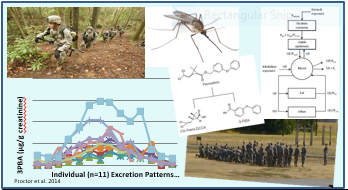Military Operational Medicine (JPC-5)
What's in Your Uniform? An Investigation of Permethrin-Treated Army Combat Clothing



Posted April 15, 2020
Susan Proctor, D.Sc., U.S. Army Research Institute of Environmental Medicine (USARIEM)
Henry M. Jackson Foundation for the Advancement of Military Medicine

Dr. Susan Proctor
Since 2013, the U.S. Army has required that all personnel wear permethrin-treated uniforms in garrison and in theater. Permethrin is a synthetic pesticide used as a repellent to prevent arthropod bites and protect against arthropod-borne diseases, such as malaria and Lyme disease. Such disease conditions pose significant threats to mission readiness and also may cause serious, life-long health consequences. The primary health symptoms reported following more acute, short-term human exposure to permethrin include skin irritation and prickliness, itching, and tingling of the skin (paresthesia). However, the potential does exist for longer term health issues since permethrin has been classified by the US EPA as a potential carcinogen based on animal studies. In addition, animal studies have observed progressive motor dysfunction accompanied by changes similar to the neurodegenerative processes characterizing Parkinson’s Disease. These factors underscore the possibility that permethrin, although considered to be safer than other pesticides currently on the market, may still pose potential health risks.
Exposure to permethrin, which is metabolized quickly in the body and excreted through the urine, can be measured by quantifying the urinary biomarkers 3-phenoxybenzoic acid (3-PBA) and the cis-, trans- isomers of 3-(2,2-dichlorovinyl)-2,2-dimethyl-cyclopropane-1-carboxylic acid (cis-, trans-DCCA). Limited human research is available that details the relationship between wearing permethrin-treated clothing, such as commercially available outdoor wear or military uniforms, and degree of permethrin exposure.
As an initial step towards addressing the need for essential exposure assessment of permethrin through wearing of treated uniforms, Dr. Susan Proctor and colleagues demonstrated that the duration of permethrin-treated uniform wear-time was significantly associated with permethrin biomarkers in Soldiers (1). In particular, military personnel research participants wearing treated uniforms in an operational scenario (33 hours consecutively) had significantly higher permethrin metabolites in urine than those wearing the uniforms in a garrison scenario (8 hours/day for 3 days). Furthermore, all individuals showed elevated levels of permethrin metabolites in urine after just 6 to 10 hours of donning the treated uniform. These elevated levels of permethrin metabolite began to subside 24 hours after removal of the uniforms.
Based on these results, Dr. Proctor and colleagues designed further studies to explore factors that may modify exposure level in personnel required to wear permethrin-treated uniforms on a daily basis. In one study, the effects of wearing treated uniforms in a high-heat environment (35°C, 40% relative humidity), conditions commonly encountered at military training facilities located in the southern United States, and in recent conflict zones, were explored. Results from this work indicated that permethrin biomarkers were significantly elevated in participants wearing treated uniforms in high-heat environments relative to those wearing treated uniforms in ambient conditions (2, 3).
Additional studies considered the role of modifiable factors on permethrin exposure in US military personnel. A Fiscal Year 2014 Injury Prevention, Physiological and Environmental Health Award to Dr. Proctor, from the DOD’s Defense Medical Research and Development Program, focused on providing critical dosimetric data related to permethrin exposure and evaluating the individual health symptom risks to military Service members wearing treated uniforms in field training settings. The project included two studies; the first examined these factors among new Army recruits (n=60) during their 10-week initial basic combat training, and the second focused on Army National Guard Soldiers (n=50) during their 2 week summer annual training period. The involvement of Army trainees in the first study allowed for the examination of exposure levels in individuals who had not previously worn these treated uniforms, while the inclusion of National Guard Soldiers in the second study provided a realistic snapshot of exposure levels in individuals wearing their own uniforms of varying age (and laundering histories). Similar to previous studies, exposure was measured through the three urinary biomarkers for permethrin. Additionally, total energy expenditure was measured following the doubly-labelled water method and coupled with wearing an accelerometer to measure energy expenditure during specified times. In the study involving new Army recruits, the highest levels of permethrin metabolites were detected during the first week of training and decreased over time. In addition, results indicated that having 10% higher percent body fat was significantly associated with 4.4% higher 3-PBA and 10% higher total daily energy expenditure was associated with 10.6% higher 3‑PBA. In contrast, results from National Guard study showed no significant association between percent body fat or total energy expenditure and permethrin exposure across their annual training period. However, a significant interaction effect was found between laundering history and percent body fat, in that 10% higher percent body fat was significantly associated with 25% higher 3-PBA among those wearing uniforms washed less than or equal to 25 (compared to greater than 25) times.
Across these studies, permethrin exposure while wearing treated clothing was considerably higher than the average US population levels reported by the Centers for Disease Control and Prevention (4). However, although there was variation, this research found that the computed permethrin daily dose estimates across studies still remained below the recommended guidance levels predictive of increased health risks. Notably, no acute health effects have been observed in any of the studies conducted by Dr. Proctor and her group. Results from the studies described above, published in Toxicology Letters (Army recruit study; 5) and Journal of Occupational and Environmental Medicine (National Guard study; 6), provide needed insight to inform human health policies for the U.S. military and other communities. The research done by Dr. Proctor highlights the importance of validated predictive models for examining the potential health risks of repeated low-dose permethrin exposure.

Publications:
(1) Proctor SP, Maule AL, Heaton KJ, and Adam GE. 2014. Permethrin exposure from fabric-treated military uniforms under different wear-time scenarios. J Expo Sci Environ Epidemiol 24(6):572-8.
(2) Proctor SP, Maule AL, Heaton KJ, Cadarette BS, Guerriere KI, Haven CC, Taylor KM, Scarpaci MM, Ospina M, Calafat AM. 2019. Permethrin exposure from wearing fabric-treated military uniforms in high heat conditions under varying wear-time scenarios. J Expo Sci Environ Epidemiol doi: 10.1038/s41370-019-0120-y [Epub ahead of print]
(3) Maule AL, Heaton KJ, Cadarette B, Taylor KM, Guerriere KI, Haven CC, Scarpaci MM, Kenefick RW, Ospina M, Calafat AM, Proctor SP. 2020. Effect of environmental temperature and humidity on permethrin biomarkers of exposure in U.S. Soldiers wearing permethrin-treated uniforms. Am J Trop Med Hyg Mar 30. doi: 10.4269/ajtmh.19-0543. [Epub ahead of print]
(4) Center for Disease Control and Prevention (CDC), 2019. Fourth National Report on Human Exposure to Environmental Chemicals, Updated Tables, January: Volume 1. 2019. Available at: https://www.cdc.gov/exposurereport/pdf/FourthReport_UpdatedTables_Volume1_Jan2019-508.pdf
(5) Proctor SP, Scarpaci MM, Maule AL, Heaton KJ, Taylor K, Haven CC, Rood J, Ospina M, Calafat AM. 2018. Role of body composition and physical activity on permethrin urinary biomarker concentrations while wearing treated military uniforms. Toxicol Lett (299):210-217.
(6) Scarpaci MM, Haven CC, Maule AL, Heaton KJ, Taylor KM, Rood J, Ospina M, Calafat AM, Proctor SP. 2020. The effect of body composition and energy expenditure on permethrin biomarker concentrations among US Army National Guard members. JOEM 62(3):210-216.
Disclaimer: The views expressed in this article are those of the authors and do not necessarily reflect the positions or policies of the U.S. Department of Defense or the U.S. government.
Link:
Technical Abstract: Permethrin Exposure Dosimetry: Biomarkers and Modifiable Factors
Last updated Friday, March 7, 2025














